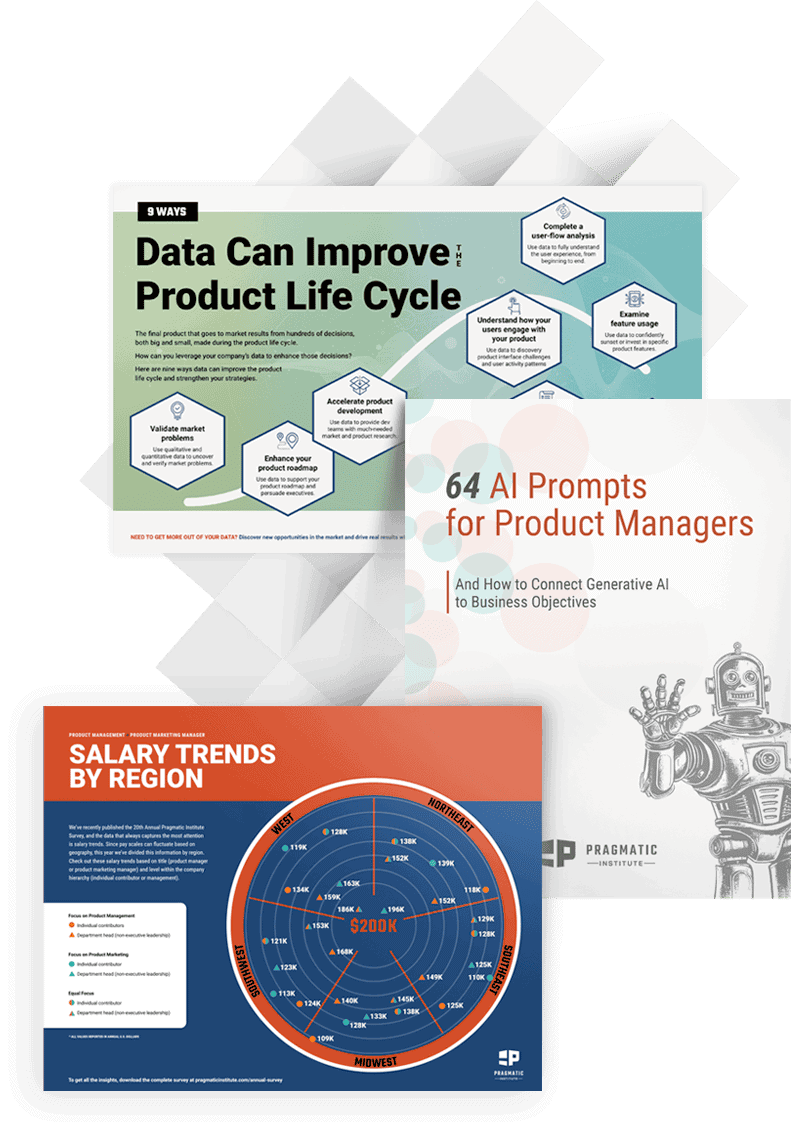9 minute read
This article explores 11 key skills you’ll learn from product management training. We’ll cover the importance of key skills, their relevance for individual contributors, and they can benefit product teams and organizations.
Product management training equips professionals of all stripes with essential skills needed to align products to market needs, strategically guide product development, and instill confidence through data-driven decision making. Whether you’re in product management, marketing, or operations, product management training provides the fundamental knowledge and tools you need to build valuable and profitable products.
If you’re exploring professional development options for yourself or your team, you may be wondering what you learn in product management training. In this article, we explore foundational knowledge and skills for product management, which you can use whether you’re honing your professional skills or just beginning your career.
11 Skills You’ll Learn in Product Management Training
The following are eleven essential skills taught in a thorough product management training program. All demonstrate importance for organizations and have relevant benefits for individual learners as well as product teams. As you evaluate product training options, look for curriculum that addresses these essential skills.
Market Expertise
Every product team wants to build products their customers love, and that generate results for their business. To do that, exploring the market of customers and competitors is essential to strategically position and design a product that can gain a foothold in a competitive marketplace. What do your potential customers want or need? Are they satisfied with current offerings? Most importantly, what are they willing to pay for a satisfying solution? When you answer these questions, you can build products that solve urgent, pervasive problems that your market is willing to pay to address.
Why it’s important: Market expertise infuses your product strategy with real-world considerations of your competitive market and your customers’ needs. This helps to align business goals with market demand.
Benefits for individuals: As an individual product contributor, building market expertise helps foreground market data in all product decisions. Focusing on the market introduces a repeatable process for market research. Most importantly, you’ll have the information you need to confidently make product decisions based on data, not on hunches.
Benefits for teams: Product team training that builds market expertise helps to create a shared understanding of the market, competitors, and customers. That common understanding can reduce the risk of rework, or of building products or features that are irrelevant to the target market. Instead, market expertise enables teams to focus on building products that solve urgent, pervasive problems.
Product Planning
Product planning is the ongoing process of strategically developing and managing a product concept through development, to launch, and ultimately through the product life cycle. It includes all the steps, tasks, and decisions required to build, launch, and maintain the product itself. Product planning is an ongoing process, allowing teams to adapt to changing priorities, shifting market demands, and changing competitive dynamics.
Why it’s important: Strategic product planning provides a consistent process for scoping, selecting, and developing products. Every new feature or product requires a massive investment of time and resources. Product planning ensures that those resources are put to good use. Product planning maintains focus on long-term goals while helping teams remain agile.
Benefits for individuals: As an individual contributor, proper product planning can help you make recommendations and proposals that align with broad business goals and that serve the long-term vision for the product. Ultimately, considering the vision for the product months or years down the road can help you prioritize impactful work. This builds credibility when leading cross-functional teams and advocating for product decisions with stakeholders.
Benefits for teams: Supporting a product through its life cycle requires coordination from many different teams. Thorough product planning ensures that those teams all understand the long-term plans for the product. Product planning also sets a precedent for a clear planning cadence, ideally creating structure and systems that reduce spur-of-the-moment product decisions and conserve valuable team resources.
Product Roadmapping
A well-constructed product roadmap is a powerful tool to achieve internal and cross-functional alignment. Product roadmapping is an ongoing process that requires care, consideration, and attention to detail. Product managers are often responsible for gathering information, selecting a format, and creating the visual roadmap. This is a heady responsibility because it requires input from many different teams and must strategically align with business goals. It’s also likely that the roadmap will change over time, so it’s essential to maintain an updated roadmap and communicate changes to relevant teams.
Why it’s important: A product roadmap is a valuable tool because it sets a clear precedent for prioritization and serves as a shared artifact for different teams. It simultaneously articulates a clear vision for the product while managing expectations.
Benefits for individuals: For individual product professionals, product roadmaps can help define product priorities, align different teams on timelines and deliverables. They are also a helpful communication aid because they are a visual representation of strategic product planning. As such, they can be a powerful tool to facilitate stakeholder communication and secure buy-in.
Benefits for teams: Many of the benefits that product roadmaps present for individuals also benefit teams! Because they are clear and consistent visual artifacts, an entire team can point to a single product roadmap to understand where they are today and where everyone hopes to end up. It can also clarify dependencies across teams and departments.
Feature Prioritization
Feature prioritization is the process of identifying and ranking by order of importance the product features that should be launched or upgraded. How these features are prioritized might depend on the feature’s impact to users, the feasibility of developing it, the potential downstream business impacts, or a variety of other factors. Introducing repeatable criteria into the feature prioritization process provides a clear method of making difficult decisions.
Why it’s important: Feature prioritization is an essential product skill because it focuses on what will matter most to the market, ultimately maximizing the value of the product. A consistent method of prioritization can prevent product teams from spreading resources thinly to develop many features. It also enables teams to allocate resources to building the select features that will matter most.
Benefits for individuals: Product managers are responsible for gathering the inputs used to rank features. Ultimately, they guide the decision of what features are developed, launched, and improved over time. Consistent processes can help you confidently make difficult decisions while always prioritizing the user, even if the loudest internal voices disagree. Additionally, proper prioritization documents that you are prioritizing features based on business impact and value for the user.
Benefits for teams: For product teams, competing priorities and contradictory requests from stakeholders can slow down development and even delay launches. Clear processes for prioritization can help reduce churn, minimize rework, and help product teams work through backlogs efficiently.
Win/Loss Analysis
Win/loss analysis is the process through which organizations, led by the product manager, gather data from won customers and lost prospects. Using qualitative and quantitative feedback, product teams can identify key reasons why a customer chose to buy, chose not to buy, or even bought from a competitor.
Why it’s important: Anecdotes from your sales team may not give you the full picture of why your product won or lost a customer. Objective and thorough win/loss analysis can uncover your company’s distinctive competencies, the features or functions that set your product apart from the pack. It also reveals the dealbreakers that your product can improve upon.
Benefits for individuals: When done right, win/loss analysis lets product managers peek under the hood and provides data about what customers truly value from your products. If needed, it also equips you with real buyer feedback that can be used to advocate for changes to your product.
Benefits for teams: Win/loss analysis helps product teams practice what they preach – listening to the market and making product decisions that are driven by real-world data. Integrating win/loss learnings into team processes encourages continuous improvement. Sharing insights helps to strengthen cross-functional collaboration and ensures that different teams – product, marketing, sales, and others – are marching to the same drum.
Data-Driven Decision Making
Data-driven decision making may be a product professional’s most important “soft” skill. Product managers are responsible for synthesizing information about their market, competitors, current and potential customers, and the product itself. This data informs decisions that shape the future of their product. By considering market research, user feedback, financial projections, and internal team workloads (among many, many other variables), product managers can optimize for the most desirable outcome.
Why it’s important: Data analysis helps to identify patterns and uncover trends, which can be a massive advantage for organizations that desire to innovate. Data can help to challenge internal narratives, and looking to the data before making important decisions can prevent organizations from making decisions based on unchecked gut instincts, strong emotions, or past biases.
Benefits for individuals: For individual professionals, developing the skill of data-driven decision-making bolsters your credibility. Translating evidence into compelling user stories can help you advocate for product decisions and enables you to move projects forward.
Benefits for teams: Teams in data-driven organizations benefit from transparency and accountability in prioritization of initiatives and evaluation of results. Incorporating real market data into decisions helps increase agility and reduces effort spent on projects that won’t drive business outcomes.
Product Launch Strategy
Product launch strategy includes the tactical plan to launch a new product or service to the market. This includes the channel selection, content creation, messaging, and activation needed to generate excitement about a product. While go-to-market (GTM) strategy looks at the big picture of bringing a product to market, product launch focuses on the activities that occur closer to the launch date.
Why it’s important: Product launch strategies are essential for product teams because they connect the product to organizational goals. It ensures organizational readiness – not just product readiness – by setting expectations for the launch. More specifically, product launches translate GTM strategies into tactical actions. This sets the product up for success immediately following launch and through subsequent stages of the product life cycle.
Benefits for individuals: For individual contributors, product launch strategy helps to define launch plans, solidify tactics, and align teams and stakeholders. More importantly, a strategy defines the goals for product launch and creates a frame of reference against which to measure performance, which product managers specifically are often responsible for.
Benefits for teams: Like individuals, teams benefit from having clearly defined goals and tactics for the product launch. Documenting these with a shared product launch strategy helps to avoid misalignment, duplicated efforts, and last-minute changes which often result in wasted time, resources, and funds. Not only does a goal-driven launch strategy enable post-launch performance tracking, it provides a framework teams can use to improve future launches.
Pricing Strategy
A pricing strategy is how you decide to price a product based on the competitive landscape, the product’s unique features and quality, and the target market’s preferred price point. A strong pricing strategy balances short-term and long-term profitability for the product itself and for the business.
Why it’s important: A pricing strategy helps organizations balance the volume of sales with the value that the sales bring. This allows teams to optimize product profitability, differentiate products in the broader marketplace, ensuring market success and providing a foundation for sustainable growth.
Benefits for individuals: For individuals, product pricing strategy helps weigh the benefits and costs of different pricing models. A thorough understanding of pricing strategy, and using data to set pricing, can help prepare you to defend pricing decisions and predict sales and profitability.
Benefits for teams: Organizations benefit from product pricing strategy, and when the organization benefits, teams benefit too. A data-driven product pricing strategy helps to enhance profit margins and reduce discounting, allowing for more reliable forecasting and encouraging innovative segmentation, distribution, and packaging. Additionally, shared strategy helps to align product, sales, and finance teams around the same goals and expectations.
Build, Buy, or Partner Decisions
When organizations attempt to solve market problems, they have a choice of building a solution of their own, buying a solution by acquiring a product or company, or partnering with another company that can help solve the problem. The decision to build, buy, or partner must consider the short-term and long-term benefits of each solution, as well as drawbacks, opportunity costs, and financial costs.
Why it’s important: Being judicious about build, buy, or partner decisions requires organizations to carefully assess the risks, costs, and timing of delivering different solutions. Ultimately, it encourages organizations to be judicious about how they use resources, fostering long-term strategic decision making and creative
Benefits for individuals: Individual contributors can benefit from training in making build, buy, or partner decisions because being able to make good choices expands the universe of resources available at your disposal to solve market problems. Additionally, finding an agreeable solution that matches the organization’s goals can enhance stakeholder trust in your recommendations.
Benefits for teams: Teams can benefit from careful build, buy, or partner decisions in several ways, most notably by tapping external resources to avoid duplicative efforts, introducing skills that the current team does not have, and accelerating time-to-market.
Product Positioning
Product positioning requires product teams to define exactly how a product solves market problems. Positioning helps product and marketing teams craft messaging that is compelling to the target audience. It should clearly articulate the market problem, pinpoint the ideal solution, and demonstrate why and how the product solves that problem.
Why it’s important: Even the best products can fail to capture their market without clear positioning. Product teams should translate a product’s capabilities into meaningful, value-based messaging that connects with their target markets.
Benefits for individuals: Honing product positioning skills can improve your messaging, value propositions, and competitive differentiation. Ultimately, strong product positioning demonstrates that you understand how the product delivers value for the user and supports the brand.
Benefits for teams: Product teams can benefit from product positioning training because it ensures that product launches are consistent and compelling. Strong product positioning helps to guide the development and launch of the product, which reduces the disconnect between what is built (and why) and how the product is messaged and sold.
Author
-

The Pragmatic Editorial Team comprises a diverse team of writers, researchers, and subject matter experts. We are trained to share Pragmatic Institute’s insights and useful information to guide product, data, and design professionals on their career development journeys. Pragmatic Institute is the global leader in Product, Data, and Design training and certification programs for working professionals. Since 1993, we’ve issued over 250,000 product management and product marketing certifications to professionals at companies around the globe. For questions or inquiries, please contact [email protected].
View all posts








